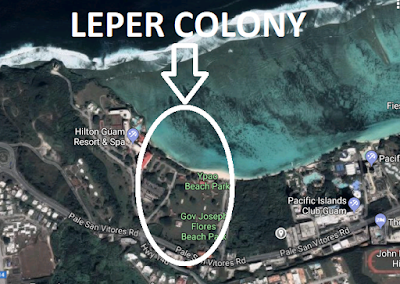Ipao Leper Colony
Secondly, many other skin conditions and diseases have been misidentified in the past as leprosy, and this certainly did happen in the Marianas in the past. At times, people just assumed a disease was leprosy, or classified all skin diseases or ulcers as "leprosy," even when they were not, so I put "leper" in quotation marks for that reason as well.
Since the disease can be spread person to person, isolation was a key method of handling cases of leprosy. The Spaniards did this by opening leper colonies or residences in various place, such as Pågo, Adilok (Adelup) and Asan Point.
A Leper Colony used to front this beach at Ipao
In the meantime, a passing American Naval officer recommended that these lepers, living among the general population, be sent to Molokai, where a famous leper colony was run and attended to at one time by Saint Damien. It never happened.
As often happened in the past, and as would be repeated in the future, some families were horrified at the thought of losing their family member sick with leprosy. So many of them hid them inside their homes, rather than let them be discovered and taken away.
GOVERNOR SCHROEDER CHOOSES TOMHOM
The old leper facility at Asan Point had been destroyed and the site was used for the Filipino political prisoners, such as Mabini. So, a new site for a leper colony had to be found. Ipao Beach in Tomhom (Tumon) was selected. Thirty acres (some accounts say 29) were required and funds from Washington DC were requested to pay back the original landowners. Schroeder sought, and obtained, the support of Padre Palomo. Schroeder was hoping Palomo could find Catholic sister nurses to come to Guam and attend to the lepers. This never came about.
By the summer of 1902, news reports around the US were talking about the new leper colony at Ipao. The first houses were of thatched roof. On the premises were a hospital, a mess hall, kitchen chapel. There was a residence for the superintendent and two watchmen.
Site of the Leper Colony
Leprosy Patients at Ipao
TRANSFER TO CULION
The leper colony at Ipao was not dismantled immediately. It was used again briefly in the 1920s for new cases of leprosy, and the facility was used also for female and juvenile offenders for a time before the war. But after the war there was no trace left of the leper colony. The disease had all but disappeared on Guam by then.









USMC Henry V. Leddy was one of the watchmen later that period. He and Maria Santos Blas married in 1905. Children were John, Lucy, Daniel, and Elsie Leddy. Their private residence was on the beachfront north of the leper colony.
ReplyDelete